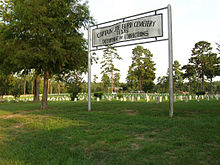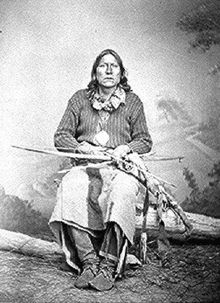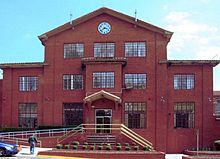- Satanta (chief)
-
This article refers to the Kiowa chief Satanta. For the Irish hero Sétanta, please see Cú Chulainn.
Satanta (ca. 1820 - 1878) was a Kiowa war chief. He was a member of the Kiowa tribe, he was born around 1820, during the height of the power of the Plains Tribes, probably along the Canadian River in the traditional winter camp grounds of his people. He was also known as Settainte (White Bear). One of the best known, and last, of the Kiowa War Chiefs, he developed a reputation as an outstanding warrior and in his twenties was made a sub-chief of his tribe, under Dohäsan, as Chief. He fought with him at the First Battle of Adobe Walls, and earned enduing fame for his use of an army bugle to confuse the troops in battle.[1]
Satanta (Set'tainte)was born the son of Chief Red Tipi and a Spanish captive and spent his youth south of the Arkansas River enjoying the peaceful alliance between the Kiowa and Comanche tribes. [2]
Contents
Orator and Warrior
Perhaps the best known leader of his tribe in the 1860s-1870's, (though Dohäsan was the overall Chief until his death),[3] he was well known for both his prowess as a warrior, and his soaring oratorical powers. Satanta was one of the Chiefs who negotiated several treaties with the American government during the 1860s, including the Little Arkansas Treaty, (1865) and the Medicine Lodge Treaty (1867). In the later, Satanta agreed that the Kiowas would live on a reservation. When the tribe failed to move onto it, Satanta was seized by General George Custer and held as a hostage until the migration took place.
At the First Battle of Adobe Walls
Satanta is primarily remembered in military history as the sub-chief to Dohäsan at the First Battle of Adobe Walls. While Dohäsan was in command of the combined Kiowa, Kiowa-Apache, and Comanche forces which opposed Kit Carson and his New Mexico forces in November 1864, Satanta is remembered for ably assisting him in repeated charges which drove the New Mexico volunteers from the field, and for his repeated blowing of an army bugle, which confused the troops under Carson. Satanta would counter Carson's bugler with trumpeted commands of his own, on a day where the Plains Tribes managed to drive a US Army from the field.[4]
At Treaties
At Medicine Lodge, Satanta, a tall, muscular man, came to be known as the "Orator of the Plains," although that title may have been a humorous reference to his long-winded speeches rather than honest praise for his speaking abilities. This is disputed however by the references papers of the day made to his speeches. Like most treaties of the time, these agreements failed utterly to bring peace on the frontier. The treaty assured rule over the vast lands given by treaty to the Kiowa, but white settlers continued to pour across Kiowa lands, and tribesmen, unhappy with the provision that reduced their domain to a small reservation, continued to raid settlements and harass immigrants. This situation, unstable in and of itself, worsened significantly with the death of Dohäsan, the last Kiowa Chief, (over the entire Kiowa People) in 1866. Without his binding personal leadership, Kiowa unity dissolved as a number of subchiefs, Tene-angopte, and Satanta, struggled for power and to fill his place. The competition between the three set off a wave of raids across the southern plains from Kansas to Texas, during the fall of 1866 and into 1867. In one instance Satanta and a joint Kiowa-Comanche war party raided into the Panhandle and, after killing James Box, captured the man's wife and four children, whom they sold to the army at Fort Dodge, Kansas.[5]
Fort Zarah
Satanta’s fame grew after the Box incident, and his ability to defuse a confrontation between the Kiowa and the US Cavalry near Fort Zarah, Kansas in 1867. A young Kiowa warrior was killed at the civilian camp near the army Fort, and the Kiowa massed to avenge his death. The cavalry, in turn, massed to protect the civilians. Satanta managed to defuse the confrontation, but nonetheless, later in the day, the Cavalry attacked the Kiowa encampment. Satanta then led the defense of the camp by the warriors while the women and children retreated. Several children were killed during the brief fight.
Warren Wagon Train Raid
- Main article Warren Wagon Train Raid.
In 1871 Satanta led several attacks on wagon trains in Texas. His undoing came with the Warren Wagon Train Raid on May 18, 1871. Immediately prior to that attack, the Indians had allowed an Army Ambulance with a small guard to pass unharmed. In it was General William Tecumseh Sherman.
The wagon train had attempted to fight the war party by shifting into a ring formation, and all the mules were put into the center of the ring. Despite this, the warriors captured all of the supplies in the train, killing and mutilating seven of the wagoneer's bodies. Five men however, managed to escape. As soon as Col. Ranald S. Mackenzie learned of the incident, he informed Sherman. Sherman and Mackenzie searched for the warriors responsible for the raid. Satanta foolishly bragged of his, Satank (Sitting Bear), and Addo-etta (Big Tree)’s involvement of the raid, and Sherman personally arrested him.
Trial of Satanta and Big Tree - First Indian Leaders Tried In State Court
Main article: SatankMain article: Texas-Indian WarsGeneral Sherman ordered the trial of Satanta and Big Tree, along with Satank making them the first Native American Leaders to be tried for raids in a US Court.[6] Sherman ordered the three Kiowa sub-chiefs taken to Jacksboro, Texas, to stand trial for murder. Satank had no intention of allowing himself to be humiliated by being tried by the white man's court, and told the Tonkawa scouts before the three were to be transported to Fort Richardson that they should tell his family they would be able to find his body along the trail. Satank refused to get in the wagon, and after the soldiers threw him in, he hid his head under his red blanket, (worn as a sign of his membership in the Koitsenko ). The soldiers apparently believed the old Chief was hiding his face because of humiliation, but in reality, he was gnawing his wrists to the bone so that he could get out of the chains they had put on him. He began singing his death song, and when his hands were free, stabbed one of his guards with a knife he had secreted in his clothes, and managed to wrestle the man's rifle from him. Satank was shot to death before he could manage to fire. His body lay unburied in the road, with his people afraid to claim it, for fear of the Army, though Col. Ranald S. Mackenzie assured the family they could safely claim Satank’s remains. Nonetheless, they were never claimed, and he lies now at Fort Sill.
At his trial Satanta warned what might happen if he was hanged: " I am a great chief among my people. If you kill me, it will be like a spark on the prairie. It will make a big fire - a terrible fire!" Satanta was found guilty of murder and sentenced to death, but Edmund Davis, the Governor of Texas, under enormous pressure from leaders of the so-called Quaker Peace Policy, decided to overrule the court and the punishment was changed to life imprisonment. Satanta was freed after two years of imprisonment at the Huntsville State Penitentiary in Texas.[7]
Release, recapture, and death at Huntsville
Satanta was released in 1873 and was alleged to be soon back attacking buffalo hunters and was present at the raid on Adobe Walls. But the Kiowa People deny he was involved in that battle, other than being present. He yielded up his war lance and other symbols of leadership to younger, more aggressive men. But his very presence at the Battle violated his parole, and the government called for his arrest. He surrendered in October, 1874, and was returned to the state penitentiary at Huntsville, Texas. Guards reported that Satanta, forced to work on the road, would stare for hours at the traditional hunting grounds of his people, and seemed to wither away. In his book, the History of Texas, Clarance Wharton reports of Satanta in prison:
-
- After he was returned to the penitentiary in 1874, he saw no hope of escape. For a while he was worked on a chain gain which helped to build the M.K. & T. Railway. He became sullen and broken in spirit, and would be seen for hours gazing through his prison bars toward the north, the hunting grounds of his people."
 Satanta was buried in the prison cemetery, now known as the Captain Joe Byrd Cemetery in Huntsville, until 1963
Satanta was buried in the prison cemetery, now known as the Captain Joe Byrd Cemetery in Huntsville, until 1963
In the end, deciding not to spend the rest of his life in prison, Satanta killed himself on 11 October 1878, by diving headlong from a high window of the prison hospital.[8] Satanta was originally buried in the prison cemetery in Huntsville. In 1963 his grandson, an artist named James Auchiah, received permission to transfer Satanta's remains to Fort Sill, Oklahoma.[9]
The character of Blue Duck in Larry McMurtry's Pulitzer Prize winning novel Lonesome Dove was partially based on the life and death of Satanta.[10]
CONCLUSION
A Dedication Ceremonies for the Return of Set'tainte's Shield and Weapons was held on October 7, 2000 at Fort Sill, OK. Music was by the 77th Army Band; Post of Colors was by the 9th & 10th Horse Cavalry Association and the Kiowa Marine Corps Veterans Association. The Invocation in Kiowa was by Atwater Onco; Flag song by Parker Emhoolah; History by Kendall Washburn; Remarks by Fort Sill Chief of Staff Colonel David C. Ralston; Presentation of Gifts by Chief Satanta (White Bear) Descendants; Chief Satanta War Song was sung by Parker Emhoolah and Singers; a Gun Salute and Bugle Call and Smoking Ceremony ended the ceremony. In 1963 by special act of the Texas legislature and Governor John Connally, Satanta's remains were located to a place of honor on Chief's Knoll in the Fort Sill Cemetery. The return of the sacred Sun Dance shield and the bow and arrows, quiver & bow case, to Fort Sill has been made possible in cooperation with the Phoebe A. Hearst Museum of Anthropology, University of California in Berkeley and the Missouri Historical Society in St. Louis. [11]
See also
- Warren Wagon Train Raid
- First Battle of Adobe Walls
- Second Battle of Adobe Walls
- Lone Wolf (Kiowa)
References
- ^ , http://www.tshaonline.org/handbook/online/articles/SS/fsa33.html
- ^ "The Long Journey Home Dedication Ceremonies for the Return of Set'tainte's Shield and Weapons"
- ^ , http://www.santafetrailresearch.com/trail-photo-02/wc-satanta-set-tain-te.html
- ^ , http://www.tshaonline.org/handbook/online/articles/AA/qea1.html
- ^ , http://www.tshaonline.org/handbook/online/articles/SS/fsa33.html
- ^ , http://www.tshaonline.org/handbook/online/articles/SS/fsa33.html
- ^ , http://www.tshaonline.org/handbook/online/articles/SS/fsa33.html
- ^ , http://www.spartacus.schoolnet.co.uk/WWsatanta.htm
- ^ "Santanta." Handbook of Texas. Retrieved on October 26, 2010.
- ^ "The Salt Creek Massacre". Indian Relations In Texas. Texas State Libraries and Archives Commission. November 2, 2005. http://www.tsl.state.tx.us/exhibits/indian/showdown/page1.html. Retrieved August 28, 2010.
- ^ "The Long Journey Home Dedication Ceremonies for the Return of Set'tainte's Shield and Weapons
External links
Categories:- 1874 in the United States
- 1878 deaths
- American people who died in prison custody
- American prisoners sentenced to death
- Battles involving the Comanche
- Kiowa tribe
- Military personnel who committed suicide
- Native American leaders
- Native American people of the Indian Wars
- People who committed suicide in prison custody
- Prisoners sentenced to death by Texas
- Prisoners who died in Texas detention
- Suicides by jumping from a height
- Suicides in Texas
- Texas–Indian Wars
- Year of birth uncertain
Wikimedia Foundation. 2010.


